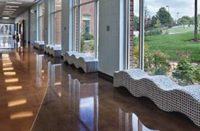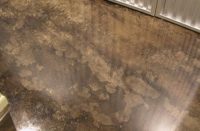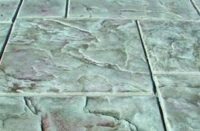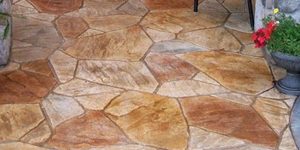
There’s good news on the horizon: With the housing market in recovery, business is definitely looking up for concrete contractors involved with stamping and texturing.
However, it isn’t just the residential outdoor market that’s driving stamping. Thanks to its low price compared with other outdoor decor options, it’s topping the lists of more commercial developers and government contractors.
Most manufacturers haven’t made significant changes to their existing technologies. Still, colors and looks are evolving, and one firm — Oceanside, California-based Proline Concrete Tools — says (at press time) it will launch what it feels is a major revolution in mat construction starting with this year’s World of Concrete show.
A boom market
Manufacturers and contractors alike feel the market for stamped and textured concrete has recovered nicely from the country’s recent recession, and some say it’s booming.
“It’s definitely strong around Indianapolis,” says Steve VandeWater, whose employer, Sagamore Ready Mix, is based in Fishers, Indiana. “This past year was by far the busiest year ever. Every contractor I talked to was just swamped with work, and they’re already getting work lined up for this spring.”
“It comes and goes, but basically we’ve seen a moderate increase in the use of stamps,” says Tim Frazier, trainer and tech supervisor for The Stamp Store in Oklahoma City. “It’s a combination of growing residential sales and people understanding how stamped concrete can work for them.”
Kelly Paxton, a customer service specialist for the Ontario, California-based Matcrete Decorative Concrete Products, says she’s seeing interest going well beyond homeowners redoing their patios. “We’re seeing it in commercial developments,” she says. “People want to have something that gives a bit more of a personal touch, even in a commercial environment. We’re also seeing it in theme parks.”
Cameron Morgan, owner of Pacific Concrete Images in Laguna Hills, California, agrees. He says shopping center and mall owners are looking for different types of decor, and stamped concrete is a very cost-effective way to spice up a project’s look. In particular, there’s more demand for custom-made deep colors, including blue and yellow, for the patterns.
“One was for an Anaheim (California) project where they were doing the image of a river, with brown on the sides to show the banks,” he says. “Another was for Universal Studios with a water feature.”
Another popular item both Morgan and Paxton list is animal track imprints, which Paxton describes as, “a little accessory, a finishing touch” for things such as patios. Although most contractors deal with white-tailed deer or coyote tracks, custom tracks have been ordered from both Matcrete and Pacific Concrete for national parks and the San Diego Zoo.
However, Morgan concedes his personal favorite is fossil imprints.
“For a couple of schools, we suggested at the bottom of the playground sandbox that they put in concrete and stamp it with some fossils,” Morgan says. “It’s great for the kids because they can excavate and find fossils at the bottom of the sandbox.”
Bigger, more colorful
While deep colors have found favor in some specialty projects, wood grains also gained ground in 2015. It’s just another example of stamped concrete’s ability to imitate and simulate natural products, says Robert Salinas of Stamped Artistry in Pasadena, Texas.
“Right now, faux wood is definitely a big thing,” Salinas says. In late 2015, “We did a training seminar in our parking lot, and when we did an overlay with the wood pattern, everybody went, ‘Wow.’”
In addition to wood, there’s been a big demand (literally) for mats that mimic larger stones and tiles, notes Tyler Irwin, Proline’s national sales manager.
“If you go to a tile or natural stone store, you can’t find anything that’s less than 16-by-16 inches,” he says. But, typically mat patterns are 12-by-12 or 14-by-14. So, “Over the last two or three years, we’ve been addressing that by creating new (tile and random stone) designs that have giant stones in them.”
Paxton says Matcrete also recognizes that trend, but it has its place. The larger designs are great for expansive spaces, he notes, but “If you have a small walkway, you want to see the pattern. You’re going to go with something that’s tighter and more traditional.”
With its focus on larger stone patterns, Proline will soon release a seamless stamp that overlaps itself and creates its own pattern. The company unveiled it as a concept at last year’s World of Concrete and has had prototypes out for several months.
“It will allow a person to stamp a pattern with the same ease as stamping a texture,” Irwin says. “Because they’re seamless mats, we’re able to make them bigger, and that allows us to put some bigger stones inside the mat.”
He compares the way the joints line up to spoons nesting in a silverware drawer, and explains that magnet technology allows the mats to align perfectly with each other. The mats themselves will also be dual density so installers can get on the concrete a bit earlier.
In fact, Irwin says, Proline is confident that installers will be able to stamp a pattern with the same level of expertise it’s taken to use a seamless skin, making the process easier and requiring less skill than in the past.
Still the basics
Regardless of what sort of a job you’re doing, manufacturers and contractors say the basics remain the same: You still need enough mats or skins to cover the width of your job in one pass.
“That’s the old rule of thumb,” says Bob Harris, a consultant with the Waxahachie, Texas, office of Structural Services Inc. “At a minimum you need to have enough tools to span the widest area you’re stamping plus an additional two tools. A common mistake of newbies is tackling too big a project without the appropriate amount of tools, and then the concrete sets too quickly.”
“If you’re working with texture skins, you need at least two,” says Sagamore’s VandeWater, “but to be practical you should have four to six skins.”
The Stamp Store’s Frazier says with his company’s stamp rental program, it typically sends out two 5-by-5-foot mats, a 3-by-3-foot mat and two 2-by-2-foot mats for a seamless texture job.
“A lot depends on the experience level of the applicator and how big the project is,” Frazier says. “The more area you’re stamping, the more coverage you want to get so you’re not slowing down.”
Other must-haves include concrete finishing tools, roller wheels to match the squeeze marks between stamps, chisels and a tamper or two. Stamped Artistry’s Salinas stresses the importance of tamping tools made for concrete stamping.
“I’ve seen some guys use dirt tampers they get at the big box stores,” he says. “That’s not good because they’re made out of metal and they’ll cut into your stamps.”
Stocking your tool box
When tool shopping, Harris advises checking out a manufacturer’s track record, particularly the level of support offered if there’s a problem with a tool.
“The goal when stamping concrete is to replicate something like stone or brick,” Harris says. “Look for a tool that’s going to produce the most realistic look once the project is completed.”
Salinas says in choosing tools, so much of it depends on what you’re comfortable with and what works best for you.
“If you’re buying online and you’re getting something for a really cheap price or it seems a lot cheaper than brand-name tools, I’d think twice,” VandeWater says. You often get what you pay for, he adds, which is why it can pay to stick with reputable companies known in the industry.

















